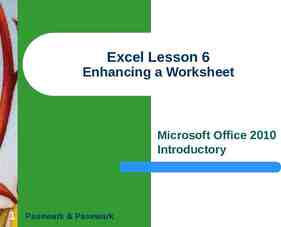Board of Assessment Review Training Session
82 Slides2.15 MB
Board of Assessment Review Training Session
Contact name title address phone e-mail
Course Outline 1. Overview of the BAR 2. Assessment of Real Property 3. Board of Assessment Review Profile 4. Grievance Day Preparation 5. Holding Grievance Hearings 6. Grounds for Complaints on Assessments 7. Determinations of the BAR 8. Second Meeting of the BAR and Subsequent Complaint Routes for Taxpayers
The Real Property Tax Ad Valorem Tax – based on ‘value’ Value is defined as ‘market value’ Tax is determined by municipal budgets Equitable assessments fairly distribute the property tax Property owners can only grieve their assessments, not their tax amount
Responsibilities of the Assessor Discover, list, and place a value on all real property Establish market value as of July 1st of prior year (valuation date) Assess according to ‘condition and ownership’ as of March 1st (taxable status date) Determine exemption eligibility
Role of the BAR Quasi-judicial body Each member should possess judicial temperament provide a fair hearing safeguard due process of law withdraw from a case if disqualified based on personal interest
Role of the Assessor in relation to BAR Assessor files a tentative assessment roll by May 1st Assessor publishes notice of filing which includes dates and times that the BAR will meet Assessor must attend all public BAR hearings Assessor has right to be heard/minutes recorded on any complaint
Complaint Process for Taxpayer If Taxpayer believes assessment is too high may first discuss with the assessor and reach agreement Administrative Procedure for assessment complaints file a petition with the Board of Assessment Review Judicial Review Small Claims Assessment Review (hearing officer) Tax Certiorari (court proceeding)
Key Dates in the Assessment Process* Valuation Date Taxable Status Date July 1st Exemption Filing Deadline March 1st Tentative Roll Filed May 1st Grievance Day May vary in towns with shared Assessor Final Roll Filed * in most municipalities 4th Tuesday in May July 1st
Unit 2 Assessment of Real Property
Assessment of Real Property NYS Real Property Tax is an “Ad Valorem Tax” Tax based upon the value of property RPTL 300 - all real property is subject to taxation unless specifically exempted by law RPTL 302 - real property must be assessed according to its condition and ownership as of taxable status date
The Standard of Assessment RPTL 305 - Real Property Tax Law Section 305 states: “.all real property in each assessing unit shall be assessed at a uniform percentage of value.” “Value” has been defined by the courts to mean market value.
The Standard of Assessment Level of Assessment / Uniform Percentage of Value What is it and who selects it? LOA – percentage of value used by an assessing unit to calculate assessments for all real property on the current roll Uniform percentage of what value? Opinion of Counsel 1-7: (The) full value standard for all property must be based on the same market value period and is the price a willing buyer would pay a willing seller under ordinary conditions for such real property.
Assessment of Real Property Level of Assessment (Uniform Percent of Value) is determined by the assessor and must appear on roll and bill Example: if level of assessment is 50%, a property assessed at 125,000 indicates an estimated market value of 250,000 ( 125,000 / .50 250,000) Ad valorem is a tax based on value, not on ability to pay or any other personal issue
How is Market Value Determined? The assessor does not set Market Value Market Value is determined by analyzing valid real estate sales “arms length” sales - willing buyer / seller under ordinary conditions Market Values are then applied to all properties in the town
Three Approaches to Value Sales Comparison Approach Compare the subject property to others like it that have sold recently Income Approach Determine value based on the rental income the property is capable of earning Cost Approach Compute the cost of building a similar structure on a similar site
Assessment of Real Property Reassessment Systematic review of all locally assessed property in the municipality Systematic analysis is a methodical, thorough and regular review and examination of assessments
Assessment of Real Property CAMA - Computer Assisted Mass Appraisal Involves the valuing of a group of properties as of a particular date using common data, standardized methods and statistical testing Assessments to Sale Price ratios are used to determine trends Different areas or neighborhoods can have different trends
Unit 3 Board of Assessment Review Profile
Profile of the BAR Appointed by legislative body Composition 3-5 members 5 year staggered terms
Qualifications Knowledge of property values 18 years old U.S. citizen Resident of the municipality Must take and file an oath of office
BAR Responsibility Exercise sound judgment be impartial be objective state reason for making determinations
Training and Certification New BAR appointees and re-appointees must attend this class to participate at Grievance Hearings Certificate of Attendance provided
Disclosure of Interest BAR members must file a disclosure form for any property in which the Board member has a direct or indirect interest intentional failure to disclose such interest may result in a civil fine for each omission Recusal from proceedings in any such case is also required
Unit 4 Grievance Day preparation
Grievance Day Preparation Organizational meeting BAR selects its own chairperson Chairperson’s role facilitate the meeting, keep order, administer oaths BAR plans time and place for hearings administrative tasks – minutes
Informational Meeting with Assessor Invite the Assessor to discuss: Tentative assessment roll Assessor’s techniques and methods for valuation Changes in law, new information Volume of complaints to expect Specific parcels should not be discussed
Grievance Day Preparation Grievance Day is 4th Tuesday in May in most municipalities local law can be adopted to change that date if the assessor is in more than one town, but no later than 2nd Tuesday in June Board members must have training certification
Assessors Rights Right to attend all public meetings of BAR Right to be heard and present information on the assessment in question Right to ask for an adjourned hearing date on a complicated case Right to have their assessment considered correct until evidence suggests a change is warranted
Unit 5 Holding Grievance Hearings
Holding Grievance Hearings Grievance hearings must be held in compliance with open meetings law (Public Officers Law, Article 7) accessible, open to public adequate space for the hearing BAR will meet to make final determinations executive session, closed BAR must conduct hearings as a body
Quorum Requirements for Hearing Minimum number of members must be present to conduct hearings 3 member board – 2 must be present 4 or 5 member board – 3 must be present
Complaint Requirements Must be filed in a timely manner complaint may be filed with the assessor prior to grievance day or with the BAR on grievance day Adjourned hearing dates assessor may request further documentation required too many complaints to hear
Seating Arrangement Accessible to public Separate from other business Provide separation between BAR, assessor, and taxpayer
Powers and Duties of the BAR Administer oaths Take testimony Hear proofs Require personal appearances Require more information Determine the final assessment
Assessors Role in Hearings Give testimony in defense of an assessment Recommend a reduction in assessment Stipulate to an assessed value All assessor comments must be made during public hearing
Hearing Testimony and Taking Proof Evidence should accompany the complaint filed Complainant can offer additional documentation at the hearing All oral and written testimony is taken under oath Each person testifying is sworn in individually
Hearing Testimony and Taking Proof Personal appearances not necessary for all Board may require a personal appearance require additional information willful neglect Minutes minutes of the proceedings must be taken and filed with the town clerk
Holding Grievance Hearings Keep an open mind all persons involved have a full opportunity to make statements, present testimony and produce evidence Objective is to seek out all the facts so that a fair decision can be made
Holding Grievance Hearings Control of the hearing at discretion of the BAR questioning the complainant, witnesses and assessor order of proof taken, evidence weighed common sense should be exercised to conduct an orderly hearing
Unit 6 Grounds for Complaints on Assessments
Presumption of law that the assessors value is correct
Burden of proof is on the complainant
Complaint Form RPTL 524 (3) requires complainants to file a written complaint on a prescribed form (RP-524) form must be completely filled out so that parcel can be identified and to give the board a clear understanding of what is being requested not the job of the BAR to “fill in the blanks” on behalf of the complainant
Complaint Form (RP-524) PART I - general information, including: the tentative assessed value of the property as it appears on the assessment roll the property owners estimate of market value (requested reduction from assessors value) PART II - supporting documentation PART III - grounds for complaint PART IV - signed certification
Complaint Form The complaint form must include: assessed value of property owners estimate of value (reduction) grounds for complaint signed certification
Complaint Requirements Complaint must be filed with the assessor prior to grievance day or with the Board on grievance day after the board concludes its hearings it is too late to file a complaint grievances may not be filed on adjourned hearing dates
Grounds for Complaint 1. Unequal assessment 2. Excessive assessment 3. Unlawful assessment 4. Misclassification
Grounds for Complaint Unequal Assessment assessed at a higher proportion of value than other residential property assessed at a higher proportion of value than all other real property Must prove both: 1. value of complainants property and 2. average ratio of assessed value to market value (percentage of value) for which all property is assessed
Grounds for Complaint Excessive Assessment Overvaluation - a locality is assessing at 100% and the assessed value exceeds the full market value of the property taxable assessed value is excessive because of denial of all or a portion of partial exemption improper calculation of a transition assessment
Information to Support Full Value Purchase price Offering price Professional appraisal Cost of construction Rental income and expense information Purchase prices of comparable properties Full value listed on the Assessment Roll
Grounds for Complaint Unlawful Assessment property is outside the assessing jurisdiction property is wholly exempt property is a special franchise parcel
Grounds for Complaint Misclassification The property has been designated in the wrong class of property Only applies to jurisdictions which establish homestead and non-homestead tax rates and in Special Assessing Units
Grounds for Complaint In most cases a single complaint type should be indicated on the complaint form complainant should not simply select all grounds without evidence to substantiate each claim Forms should be complete before they are accepted by the board for a decision
STAR Registration Program All homeowners receiving a Basic STAR property tax exemption must register with the NYS Tax Department (DTF) in order to continue to receive the exemption This registration requirement is not satisfied by the original application to the local assessor Senior citizens receiving the Enhanced STAR exemption are not affected by the registration requirement Property owners that are denied an exemption will receive notice to appeal directly to DTF. If they are not satisfied with the DTF decision, they can appeal to State Board of RPT
STAR and the role of the BAR STAR applications denied by the assessor can be reviewed by the Board of Assessment Review There is no appeal to the local BAR for STAR exemptions directed to be removed by DTF Can the BAR reinstate an exemption that was removed for failure to register? No -The law specifically states that a BAR cannot restore the exemption removal in a registration case
Unit 7 Determinations of the Board of Assessment Review
Presumption of law is that the assessors value is correct Burden of Proof is on the complainant to prove otherwise
Complainant must present convincing evidence that the assessor’s judgment is incorrect
Convincing Evidence Such relevant proof as a reasonable mind may accept as adequate to support a conclusion of ultimate fact Demonstrates the existence of a valid and credible dispute regarding valuation Based upon sound theory and objective data rather than on mere wishful thinking
Convincing Evidence Board’s role is not to debate property taxes or tax burden BAR must remain impartial Board not expected to help the taxpayer or defend the assessor Sympathy for a property owners situation is not a valid reason to lower an assessment cannot consider ability to pay, financial hardship, personal issues etc.
Unwarranted Change No token reductions assessments should not be lowered to appease homeowners or reward them for “making the effort” to come in Remember lowering an assessment, without a valid reason, increases the tax burden for all other property owners and creates inequity on the assessment roll
Weighing the Evidence Primary duty to decide whether assessment in question is proper and equitable Has the owner filed in timely manner? clearly stated facts as basis of complaint? presented sufficiently detailed evidence to support claim? Has the assessor viewed the property? presented facts or evidence to explain the basis of assessment?
Weighing the Evidence It is not the job of the BAR to re-appraise each property in question BAR must decide if complainant has supported his complaint with evidence beyond that of the assessor
Stipulations Prior to grievance day the taxpayer and assessor may stipulate to an agreement of assessed value stipulation must be in writing on grievance form signed by the assessor and the taxpayer The BAR is expected to ratify any such stipulation no further judicial review is allowed BAR is not required to mail a notice of determination for stipulations
Grounds for Dismissal of Complaint Non-Cooperation or willful neglect: willful refusal to appear, provide relevant documents, or answer questions are grounds for dismissal the taxpayer is notified that their grievance form is incomplete or lacks information, but fails to correct it the BAR makes a reasonable request for documents or information and the taxpayer refuses or fails to supply it
Grounds for Dismissal of Complaint Non-Cooperation or willful neglect: As long as the request is reasonable, the BAR (and not the taxpayer) determines what is relevant
Powers of the BAR MAY leave original assessment unchanged lower the assessment determine how much to lower it MAY NOT raise an assessment lower an assessment to less than the amount requested
Determination Meeting After hearing all complaints, the BAR should close hearing and meet in private to make determinations Executive session - not a public meeting assessor /complainant not present no “on the spot” decisions
Determination Meeting BAR must act as Body the Board, or a majority of the board, must make a final decision on each complaint review minutes consider statements consider testimony review proofs Arrive at a decision the vote on each complaint must be recorded
Once Determinations are Made Notify Complainant of BAR Final Determination Form RP-525 - Notice of Determination Form should be filled out completely and must include the reason for determination Deliver Statement of Changes to Assessor Prior to last date for filing of the assessment roll (July 1st in most towns) Verified List of Changes should include all stipulations and grievances filed, regardless of change
Unit 8 Second Meeting of the BAR & Subsequent Complaint Routes
Second Meeting of the BAR Convened to review assessments made through the Correction of Error process (RPTL 553) Petition is submitted either by the assessor or the County Real Property Tax Director Corrects: clerical errors unlawful entries errors in essential Fact omissions Defined in RPTL 550
When is the Second Meeting? Between July 15th (15 days after the filing of the Final Assessment Roll) and not less than 20 days prior to the tax levy May have several ‘second’ meetings (prior to school levy, county/town levy and village levy) easier for the taxpayer, more cost effective for the taxing jurisdiction
Subsequent Complaint Routes Small Claims Assessment Review (SCAR) For 1, 2, or 3 family residential property owners only Must have already filed a grievance with BAR Must file petition within 30 days of completion and filing of the final assessment roll Subject to a small filing fee
Subsequent Complaint Routes Tax Certiorari For all property owners Must have filed a grievance with BAR Must file petition within 30 days of completion and filing of the final assessment roll Should involve an attorney
Subsequent Complaint Routes If a taxpayer subsequently files for Small Claims or Certiorari action, the BAR grievance form sets the parameters taxpayer cannot claim an assessed value or fair market value lower than that on the grievance form taxpayer cannot claim another grounds for relief if it is not claimed on the original grievance
Summary and Review Remember it is the value of the assessment being challenged, not taxes Presumption of law is that the assessors value is correct until proven otherwise The Burden of Proof is on the complainant to prove the basis of complaint with proper evidence Objective is to seek out all the facts so that a fair decision can be made
Summary and Review Basis of determinations: Has the property owner supplied sufficient and convincing evidence to prove the assessment is incorrect? if YES, make appropriate reduction if NO, assessment remains unchanged
Questions?
Additional Information Visit the New York State Office of Real Property Tax Services Website www.tax.ny.gov/research/property/default.htm
Board of Assessment Review Training Session























































































